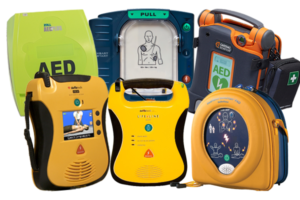 An automated external defibrillator (AED) is a great first aid asset for any workplace, community organisation or home. AEDs are recognised as one of the key parts of the Chain of Survival and can dramatically increase survival rates from sudden cardiac arrest when compared to CPR alone. However the choice of AED’s on the market is quiet extensive and comparing the different models can be difficult at times. Here are our top seven things to consider when purchasing your next AED.
An automated external defibrillator (AED) is a great first aid asset for any workplace, community organisation or home. AEDs are recognised as one of the key parts of the Chain of Survival and can dramatically increase survival rates from sudden cardiac arrest when compared to CPR alone. However the choice of AED’s on the market is quiet extensive and comparing the different models can be difficult at times. Here are our top seven things to consider when purchasing your next AED.
1. The Brand
 Automated external defibrillators are not cheap (see below) so you want to buy right the first time. It is advisable to stick to the recognised manufacturers on the market. This is to provide you with a level of confidence in their construction and build quality, their after sales support and warranty, and a continued supply of consumables going into the future. For example, if your no-name branded AED manufacturer goes out of business and you can’t source the consumables for your AED e.g. – batteries, your AED will unfortunately become obsolete. The most recognised brands on the Australian market are Zoll, Laerdal (Phillips), Cardiac Science, Physio Control and DefibTek. It would be wise to also consider how easy it will be to get service in the event that something goes wrong with your AED unit. Can you get your retailer to come to inspect the unit or will you have to post/courier the unit back to an online retailer?
Automated external defibrillators are not cheap (see below) so you want to buy right the first time. It is advisable to stick to the recognised manufacturers on the market. This is to provide you with a level of confidence in their construction and build quality, their after sales support and warranty, and a continued supply of consumables going into the future. For example, if your no-name branded AED manufacturer goes out of business and you can’t source the consumables for your AED e.g. – batteries, your AED will unfortunately become obsolete. The most recognised brands on the Australian market are Zoll, Laerdal (Phillips), Cardiac Science, Physio Control and DefibTek. It would be wise to also consider how easy it will be to get service in the event that something goes wrong with your AED unit. Can you get your retailer to come to inspect the unit or will you have to post/courier the unit back to an online retailer?
2. Ease of Use
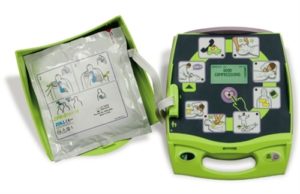
The Zoll AED Plus includes pre-connect pads, easy to follow diagrams and additional CPR guidance
One of the biggest factors to consider when buying an AED, which is also one factor that some buyers rarely consider, is the ease of use of the unit. Whilst all AED models are similar, they also have some small differences particularly when it comes to their ease of use and operation. We’ve noticed during our many years of First Aid training that these small differences can dramatically affect how easy it is for a user to operate them. In an emergency, you want your AED to be as easy to use as possible.
Things to consider include the layout of the front of the AED – is it logical? You should compare the size, location and colour of the on/off and shock buttons. Are the buttons back lit for low-light operation? Does the unit include easy-to-follow diagrams on the front of the unit? Are the pads pre-connected or does the user have to attach pads immediately before use?
What verbal and visual prompts and guidance does your unit offer? Some units will provide additional guidance when it comes to providing care to a casualty including performing CPR. For example, some units provide a metronome to guide the speed of chest compressions whilst others can provide chest compression depth feedback. Is this guidance offered automatically (recommended) or does the user have to manually press a button to activate it?
Another factor to consider is the activation of the paediatric mode (where present). To activate this child mode, some AED models come with a simple switch on the front of the unit, other units require a user to attach a separate set of paediatric pads whilst other units require the insertion of a child key which some (untrained) users may find confusing or hard to notice.
3. Training Options Available
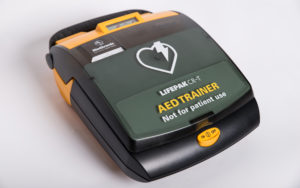
A Lifepak AED trainer unit
One important consideration when buying a defibrillator is whether you will have access to training for your particular unit. It is all well and good to purchase an AED for your workplace but it is just as important, in an emergency, to ensure that your staff have been trained to use your particular AED model. As you just learnt above, every AED model has its own idiosyncrasies which can affect its use. The easiest way for staff to become familiar with these idiosyncrasies is via CPR and AED training using an AED trainer unit that is the same as the specific model that your purchasing. Does your retailer offer this training service or can you access this training elsewhere?
4. Consumables

The AED batteries and pads of the Laerdal HeartStart FRx unit
Another important factor when purchasing an AED is to consider its consumables. The two main consumables for an AED are batteries and pads. The difference in price of AED pads and batteries can affect an AED’s running costs. Whilst one particular unit may be cheaper upfront, more expensive batteries and pads may mean this cheaper unit is actually more expensive over the long term.
Directly linked to price is the shelf-life of the batteries and pads which can vary between units. For example, in batteries this difference can be as great as four years which means you would be needing to replace your battery nearly twice as often as a different model. As you can imagine, this can significantly add to the unit’s running costs over its life. Finally, you should also consider how easy it will be to purchase these consumables. With most AED pads having an average lifespan of two years, needing to replace and order consumables will be a frequent occurrence so you need to consider how easy it will be to source these consumables going into the future.
5. Inclusions
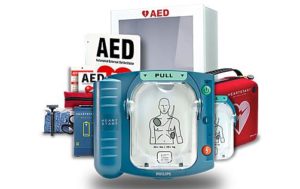
An AED package may include a range of accessories
One consideration when buying an AED is the level of inclusions. What items are included in the AED package you are looking to purchase or comparing against another? Some retailers sell AEDs with the bare minimum i.e. just the AED unit and require you to purchase additional accessories, whilst others retailers include these accessories in a single package. The accessories you need will come down to your own individual set of requirements but items to consider are protective or carry cases, a spare set of pads, an extra battery, a mounting station or wall bracket/cabinet and paediatric pads and/or child keys.
6. Price
Another key factor when purchasing any AED is its price. In the past, AEDs use to retail for over $10,000 but now some AEDS are retailing for under $2000. You will find however most AEDs currently on the market in Australia retail for between $2000 and $3500. As noted above, one important consideration when comparing the costs of particular AEDs is the price difference in their respective consumables, particularly pads and batteries.
7. Physical Characteristics
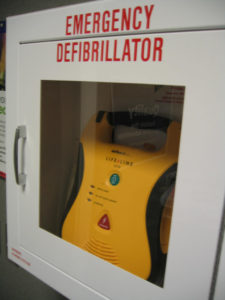 AEDs can also differ in their physical characteristics and this can be another important consideration when purchasing your AED. The physical requirements of your AED will differ depending on its end use. For example, is the AED going to be stationary in an office environment or are you expecting to take it on remote trekking expeditions into the wilderness? AEDs can differ particularly in their size, weight and IP rating (International Protection Rating), which is their resistance against the intrusion of solid objects or dust, accidental contact, and water. For an office environment, you may only need a lower specification unit but for a more demanding environment, a higher spec unit may be required.
AEDs can also differ in their physical characteristics and this can be another important consideration when purchasing your AED. The physical requirements of your AED will differ depending on its end use. For example, is the AED going to be stationary in an office environment or are you expecting to take it on remote trekking expeditions into the wilderness? AEDs can differ particularly in their size, weight and IP rating (International Protection Rating), which is their resistance against the intrusion of solid objects or dust, accidental contact, and water. For an office environment, you may only need a lower specification unit but for a more demanding environment, a higher spec unit may be required.
Conclusion
These seven important factors can help decide on what to look for when purchasing an AED and selecting the best model AED that’s just right for you. Let us know how you go with selecting an AED, by leaving a comment on our Facebook page and if you’re on the Mid North Coast and would like to organise defibrillator training for new purchase, get in touch with us today.
